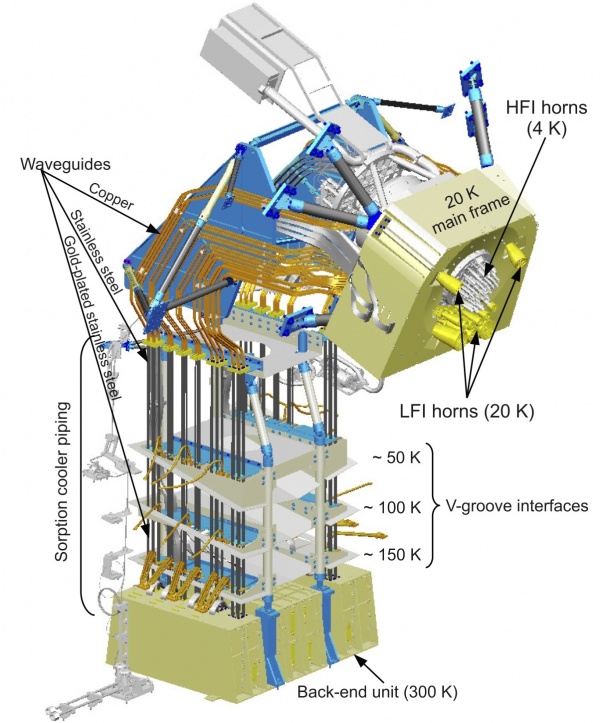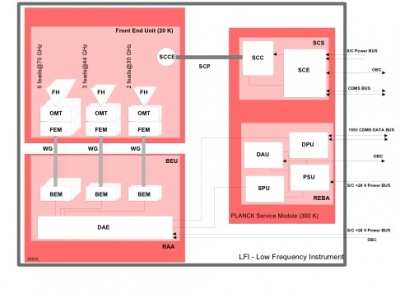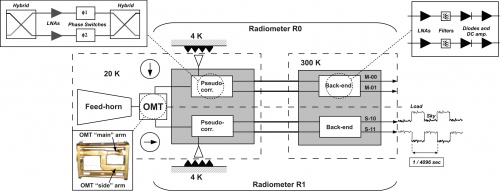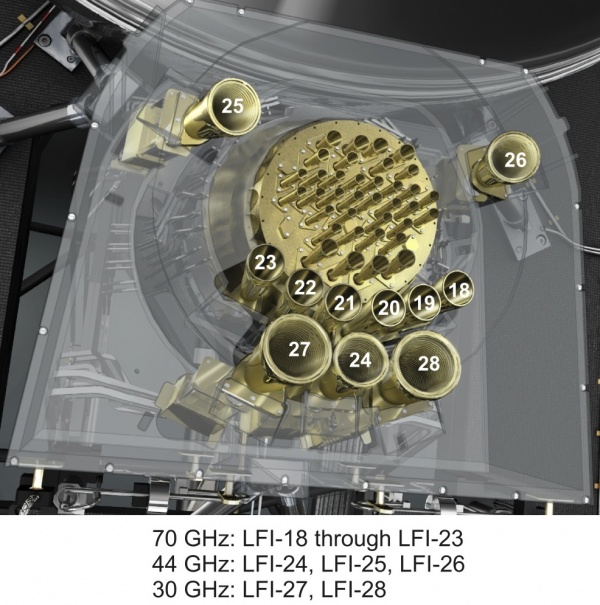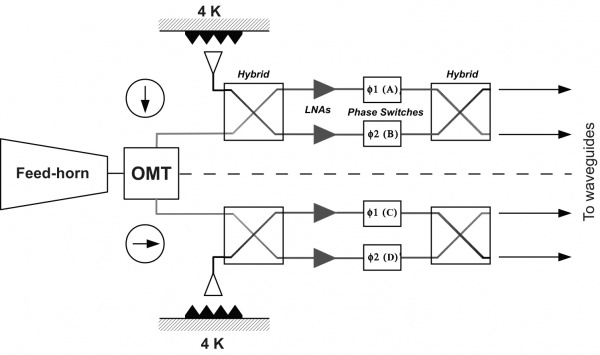Difference between revisions of "LFI design, qualification, and performance"
| Line 9: | Line 9: | ||
Only a. | Only a. | ||
| − | |||
Each LFI radiometer | Each LFI radiometer | ||
g <math>V_{sky}</math>, <math>V_{load}</math> signals at the frequency of the phase switch. By changing the phase switches configuration, the output can be a sequence of either <math>V_{sky}</math> or <math>V_{load}</math> signals. | g <math>V_{sky}</math>, <math>V_{load}</math> signals at the frequency of the phase switch. By changing the phase switches configuration, the output can be a sequence of either <math>V_{sky}</math> or <math>V_{load}</math> signals. | ||
| + | == The LFI description == | ||
| + | |||
| + | |||
| + | The Planck-LFI instrument is an array of 11 radiometric receivers in the Ka, Q and V bands, with centre frequencies close to 30, 44 and 70 GHz. The exact centre frequencies for each receiver are reported in \cite{mennella2011}; for simplicity, in this paper we will refer to the three channels using their nominal centre frequency. A detailed description of the LFI instrument is given in [M. Bersanelli, N. Mandolesi, R. C. Butler et al. Planck pre-launch status: Design and description of the Low Frequency Instrument. A&A, 520:A4, 2010], and references therein. | ||
| + | |||
| + | The instrument (see figure below) consists of a 20 K focal plane unit hosting the corrugated feed horns, the orthomode transducers (OMTs) and the receiver front-end modules (FEMs). Fourty four composite waveguides [O. D’Arcangelo, L. Figini, A. Simonetto et al. The Planck-LFI flight model composite waveguides. Journal of Instrumentation, 4:2007, 2009] are interfaced with three conical thermal shields and connect the front-end modules to the warm (~300 K) back-end unit (BEU) containing a further radio frequency amplification stage, detector diodes and all the electronics for data acquisition and bias supply. | ||
| + | |||
| + | [[File:lfi_instrument1.jpg|center|600px|The LFI instrument with main thermal stages, focal plane, waveguides and sorption cooler piping highlighted. ]] | ||
| + | |||
| + | Best LFI noise performance is obtained with receivers based on InP High Electron Mobility Transistor (HEMT) low noise amplifiers (LNAs) for minimal power dissipation and best performance. To further minimise power consumption in the focal plane, the radiometers are split into two sub-assemblies connected by waveguides, one located at the telescope focal area, the other on the 300 K portion of the Planck satellite. These design features allow the entire front-end LNAs dissipation to be <0.55 W, which enables the active cooling of the focal assembly. This is achieved with a vibration-less hydrogen sorption cooler, which also provides 18 K pre-cooling to the HFI helium J-T cooler. Because the sorption cooler is necessary to both LFI and HFI, a redundant cooler is included in the flight hardware. | ||
| − | + | As shown schematically in figure below, the LFI consists of the following subsystems: | |
| + | • Radiometer Array Assembly (RAA) | ||
| + | • Sorption Cooler Subsystem (SCS) | ||
| + | • Radiometer Electronics Box Assembly (REBA) | ||
| + | The RAA includes the Front End Unit (FEU) and the Back End Unit (BEU), connected via waveguides. The FEU is located at the focus of the telescope, as one component of the joint LFI/HFI focal assembly (see Section 3.4). The BEU is mounted on the top of the Planck SVM. | ||
| + | The Radiometer Electronics Box Assembly (REBA) and the warm parts of the Sorption Cooler System (SCS) is located on one of the lateral panels of the service module (SVM). The FEU and the Sorption Cooler Compressor (SCC) are connected by concentric stainless steel tubes. The smaller tube carries hydrogen at ∼60 atmospheres from the cooler compressors to the FEU, while the larger tube returns the hydrogen at ∼0.3 atmospheres. These units are described in detail in following sections. | ||
| + | All LFI units are linked together by the LFI harness, which also connects to the spacecraft interface. | ||
[[File:LFIblockdiagram.jpg|center|400px|Block Diagram of LFI]] | [[File:LFIblockdiagram.jpg|center|400px|Block Diagram of LFI]] | ||
| + | |||
| + | Every radiometer chain assembly (RCA) consists of two radiometers, each feeding two diode detectors (see figure below), for a total of 44 detectors. | ||
[[File:rca_schematic.jpg|center|500px|A complete RCA from feed-horn to analog voltage output. The insets show the OMT, the details of the 20 K pseudo-correlator and of the back-end radio-frequency amplification, low-pass filtering, detection and DC amplification]] | [[File:rca_schematic.jpg|center|500px|A complete RCA from feed-horn to analog voltage output. The insets show the OMT, the details of the 20 K pseudo-correlator and of the back-end radio-frequency amplification, low-pass filtering, detection and DC amplification]] | ||
| + | |||
| + | The 11 RCAs are labelled by a numbers from 18 to 28 as outlined in figure below. | ||
| + | |||
| + | |||
| + | [[File:lfi_instrument2.jpg|center|600px|Labelling of feed horns on the LFI focal plane.]] | ||
| + | |||
[[File:phase_switch_operation.jpg|center|600px|Close-up of the two front-end modules of an RCA. There are four phase switches, labelled A, B, C and D. Each switch can be fixed in one of its two positions (labelled as 0, 1) or switch at 4 kHz between 0 and 1. Phase switches are clocked and biased by the DAE in pairs: A/C and B/D (see text for further explanation).]] | [[File:phase_switch_operation.jpg|center|600px|Close-up of the two front-end modules of an RCA. There are four phase switches, labelled A, B, C and D. Each switch can be fixed in one of its two positions (labelled as 0, 1) or switch at 4 kHz between 0 and 1. Phase switches are clocked and biased by the DAE in pairs: A/C and B/D (see text for further explanation).]] | ||
Revision as of 14:48, 18 October 2012
Contents
Overview[edit]
The first :
- uno
- due
- tre
- quattro
Only a.
Each LFI radiometer g , signals at the frequency of the phase switch. By changing the phase switches configuration, the output can be a sequence of either or signals.
The LFI description[edit]
The Planck-LFI instrument is an array of 11 radiometric receivers in the Ka, Q and V bands, with centre frequencies close to 30, 44 and 70 GHz. The exact centre frequencies for each receiver are reported in \cite{mennella2011}; for simplicity, in this paper we will refer to the three channels using their nominal centre frequency. A detailed description of the LFI instrument is given in [M. Bersanelli, N. Mandolesi, R. C. Butler et al. Planck pre-launch status: Design and description of the Low Frequency Instrument. A&A, 520:A4, 2010], and references therein.
The instrument (see figure below) consists of a 20 K focal plane unit hosting the corrugated feed horns, the orthomode transducers (OMTs) and the receiver front-end modules (FEMs). Fourty four composite waveguides [O. D’Arcangelo, L. Figini, A. Simonetto et al. The Planck-LFI flight model composite waveguides. Journal of Instrumentation, 4:2007, 2009] are interfaced with three conical thermal shields and connect the front-end modules to the warm (~300 K) back-end unit (BEU) containing a further radio frequency amplification stage, detector diodes and all the electronics for data acquisition and bias supply.
Best LFI noise performance is obtained with receivers based on InP High Electron Mobility Transistor (HEMT) low noise amplifiers (LNAs) for minimal power dissipation and best performance. To further minimise power consumption in the focal plane, the radiometers are split into two sub-assemblies connected by waveguides, one located at the telescope focal area, the other on the 300 K portion of the Planck satellite. These design features allow the entire front-end LNAs dissipation to be <0.55 W, which enables the active cooling of the focal assembly. This is achieved with a vibration-less hydrogen sorption cooler, which also provides 18 K pre-cooling to the HFI helium J-T cooler. Because the sorption cooler is necessary to both LFI and HFI, a redundant cooler is included in the flight hardware.
As shown schematically in figure below, the LFI consists of the following subsystems: • Radiometer Array Assembly (RAA) • Sorption Cooler Subsystem (SCS) • Radiometer Electronics Box Assembly (REBA) The RAA includes the Front End Unit (FEU) and the Back End Unit (BEU), connected via waveguides. The FEU is located at the focus of the telescope, as one component of the joint LFI/HFI focal assembly (see Section 3.4). The BEU is mounted on the top of the Planck SVM. The Radiometer Electronics Box Assembly (REBA) and the warm parts of the Sorption Cooler System (SCS) is located on one of the lateral panels of the service module (SVM). The FEU and the Sorption Cooler Compressor (SCC) are connected by concentric stainless steel tubes. The smaller tube carries hydrogen at ∼60 atmospheres from the cooler compressors to the FEU, while the larger tube returns the hydrogen at ∼0.3 atmospheres. These units are described in detail in following sections. All LFI units are linked together by the LFI harness, which also connects to the spacecraft interface.
Every radiometer chain assembly (RCA) consists of two radiometers, each feeding two diode detectors (see figure below), for a total of 44 detectors.
The 11 RCAs are labelled by a numbers from 18 to 28 as outlined in figure below.
a tunable offset, , then it amplifies the signal with a tunable gain, ,
- Radiometer Chain Overall Design
- Radiometer Array Assembly
- REBA
- Radiometer Chain Overall Design
- Instrument On-board Software
- Instrument Operations
- Instrument Budgets
LFI Ground Tests[edit]
LFI In-flight Calibration[edit]
LFI Performance[edit]
- Instrument Scientific Performance
- Instrument Technical Performance
(Planck) Low Frequency Instrument
LFI warm electronics Back End Unit
High Electron Mobility Transistor
(Planck) High Frequency Instrument
LFI Radiometer Array Assembly
Sorption Cooler Subsystem (Planck)
LFI Radiometer Electronics Box Assembly
LFI cryogenic amplifying stage Front End Unit
Service Module
Sorption Cooler Compressor assembly
LFI Radiometer Chain Assembly
LFI Data Acquisition Electronics
